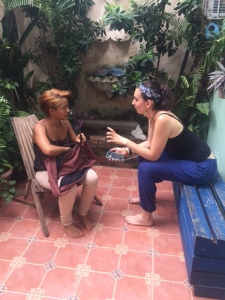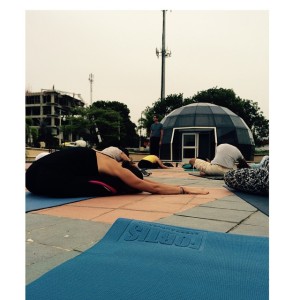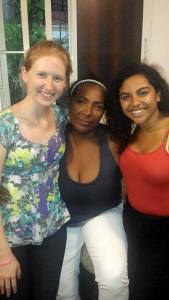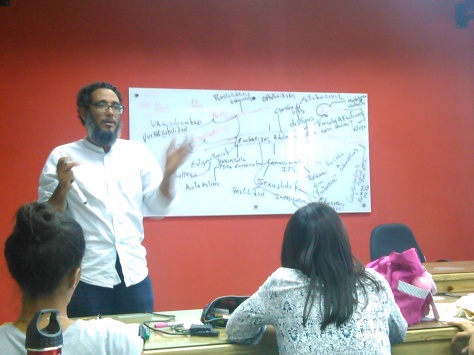By Anshu Guar
“Cereeeeasa.”
“Maango.”
“Chinhoola.”
The voice of persistent vendors filled the air, some reaching farther than others. We walked along the narrow sidewalk along street side tiendas and garbage filled gutters.
To my left was a yellow walled cafe that served Chinese food. To my right was what I had mistaken for an ordinary street, the only sense of order amongst the moving vehicles being their increased tendency to honk and swerve rather than stop. The way people drove here reminded me of India. I turned away from the chaotic road towards my own steps when I noticed him.
His body was dampened with mucky gutter water. Black and white hairs clumped awkwardly in all directions. Each step he took was small and painful. I kept walking with our group to catch the next guaga, my mind falling a little ways behind. We were on our way to the Bonjee concert, a weekly festival in Santo Domingo, with a live band, tasty street food and a bountiful moments of Latin dancing. I had been looking forward to going all semester.
Our group had been waiting for a minute or so when a white minivan arrived, the corrador (who collects money from passengers) hanging on the edge the door repeating “Parque. parque.” We began piling inside, four to a seat. I looked back towards for a second before stepping in, not so subtle whispers of “Americanas” circulating the overcrowded space. The image of his crumpled wet body beckoned to me, haunting me at the same time. Just another piece of trash in the gutter.
The next morning was the first day of volleyball camp. Volleyball always appealed to me as a child. I started playing in elementary school, but never made it past the B team. A five minute walk from the barrio, the neighborhood in which we lived, a group of kids (mostly girls in either high school or middle school) practiced every day after school. I played around a few times the week before, during which I was reminded me how I never learned how to spike a ball or serve the ball overhand. I was impressed by how well each player complemented each other and how much I had to learn about the movements and coordination.
The camp marked the beginning of their summer. Something about working together in a physical sense as part of team always felt energizing to me. I was excited for the much needed exercise to justify the copious amounts of delicious food that Nairobi, my host mother, had been feeding me. Also this was my chance to learn how to actually play and especially how to spike to ball.
I walked to the school with Patricia, my host sister. At 21 years old, she is bronze, sweet and fierce, boasting a small frame, yet toned body. I always ask her how she stays in shape to which she laughs and says, by eating a lot. Upon entering the school there lay a small patch of grass, followed by a fairly large area of ground identifiable by the structures it contained. On the side closest to the patch of grass were the two hoops indicating a basketball court. On the other end of the school were a couple of nets held in the air, signifying two volleyball courts. A rather bulky tree overflowing with an oddly shaped green fruit claimed half the land of the second volleyball court. The schoolyard was contained inside sand colored walls of concrete decorated with various clusters of graffiti.
By this week some of the kids who had not spoken to me before recognized me and began asking me questions. What was my name. Where I was from. What I was doing here. Patricia filled in whenever I could not understand their rapid Spanish. Somehow the topic of race always came up in my conversations here. When I told them my parents were from India, one of the girls asked me if I was vegetarian. I nodded. Patricia started explaining how I was actually vegan, and do not eat any products from animals – including milk and eggs.
“No comes carne?” You don’t eat meat?
They looked confused.
” No.”
“Y no comes pollo?” What about chicken?
Their eyes widened.
“Pero no tomas leche tampoco?” But no milk either?
They look around at each other, shocked.
“Porque?” Why?
“No me gusta causarles dolor a los animales.” I don’t like to hurt animals.
At first everyone either thought that I was “loco in the coco” (my roommates expression for absolutely insane).. But Patricia surprised me when she explained my dietary choices to everyone in a way did not make me seem completely insane. She spoke as a matter of fact, that if she sees the chicken being killed in front of her, she would not be able to eat it.
“No me gusta tampoco.” I do not like it either.
We continued taking brief breaks after each drill, refueling our bodies with a relieving moment in the shade and ice cold water. About two hours into the camp, we working on returning a spike in a low squat stance. My quads were on fire when I heard a gasp that gave me an excuse to stand up, relieving my muscles. Every once in a while a ball went flying in some direction of the vast schoolyard and someone would go to retrieve it. This time two or three girls had collected in the area by the concrete wall. I joined them, nosing my way in between a few shoulders to see what was up. My heart immediately sunk and I held my breath.
A familiar furry ball of black and white appeared trapped underneath a rock. His crumpled wet body squirmed to break free.
“Meow. Meow. Meow. ” Every breath was an aching yelp. This month old kitten, separated from his mother, was fighting for his life. The signals from my brain to my muscles were suddenly cut. I watched motionlessly as one of the girls slowly lift the rock. When he was finally freed from the rock’s weight, he had little energy left to move. He lay there face down in the leaves, the slightest rise and fall of his back indicating mere life. This time I could not walk away.
“Anshu!” Patricia yelled, waiting for me to come finish the drill. By this point, I was the only one left by the wall. I scooted a nearby trashcan towards the isolate spot to guard him from any other stray volleyballs that could easily crush his weak body. Only for the next hour, and then I would return, I promised to both him and myself. We continued the drill followed by a game. My mind, in synch with my rapidly beating heart, was especially alert. I cringed every time a ball went anywhere near his direction, sprinting after it as everyone watched amused by my newfound energy and determination.
When camp came to an end around noon, I immediately started walking over to the spot behind the trashcan.
“Dejélo!” Leave him. Patricia said to me.
I was afraid she might not approve. The girls from volleyball formed a semi-circle facing me, an intrigued audience, waiting to see what would happen next. In my attempt to think on my feet, I told Patricia I wanted to take him to see Dr. Pichardo, the holistic doctor we were working with for the summer, without actually considering whether he would want to see a stray handicapped kitten I picked up off the street. Patricia held her ground, pursuing every method to convince me to leave him behind.
You should ask Dr. Pichardo before just showing up at his door. If there was nowhere for him to stay, our street with all the dogs would not be a safer place than this school. If you take him his mom would be searching for him.
Somehow the thought of leaving him behind for a second time frightened me more than anything else. But Patricia was persistent and almost had me convinced when the volleyball coach mentioned that if I left him he would probably end up in the trashcan. Patricia tried to say otherwise, but after hearing that nothing could stop me.
“No puedo,” I urged Patricia, apologetically but with authority. I can’t. Left with no choice, she grudgingly agreed, making it clear he could not enter our house. I nearly knocked her over with a hug, before running over to the concrete wall. He still lay face down in the leaves. I carefully scooped him up with a few leaves that had fallen from the unknown tree and held him close to my body. With little idea of what would happen next, I silently celebrated our small victory, praying for the best.
We all walked out of the school together. Everyone was fairly surprised that I had gotten my way. If my parents are right about anything, it is definitely their conviction that I am stubborn and headstrong. On the way out of the school one of the girls spotted a cardboard box filled with empty bottles.
“Espera ,” she told me. Wait. A few others helped her empty the box, which they presented to me. It was my turn to be surprised. I gave a gracious smile to the same people who thought I was “loco in the coco”, carefully placing him inside.
ANDA, the holistic medical clinic, is just a rocks throw away from the house we live in. Once we arrived at our street, I parted with Patricia to go seek out the options. Above the clinic is a two room apartment where Tim, Alicia and Noemi – our program directors from Cornell – live. Their outdoor balcony seemed like a safe place to start. Sometimes we would come hang out there before going to our medical rotations. I made my way up the narrow windy staircase to the balcony and silently placed the box on the floor. Over the course of the next few hours as people walked in and out was a myriad of reactions.
Faces twisted in disbelief.
“What did you do?”
“Are you serious?”
Disgust.
“What is that?”
“Oh my god, are those fleas?”
Curiosity.
“Where did you find it?”
“Is it alive?”
Concern.
“Let me Google what it can eat.”
“You should probably put in a T-shirt in the box or something to make it more comfortable.”
“Let me get some water.”
Excitement.
“What should we name him?”
Pity.
“Aww poor thing.”
Doubt.
“You can’t just pick stray animals off the street . . . they could have rabies.”
“It’s not going to survive.”
Dr. Pichardo was the person whom I had the most hope in, but he was also the person I was most afraid to ask. If he did not have an answer, I really had no idea what to do. Inside the box there was little sign of life. The slight rise and fall of his back had grown even more subtle. I tentatively made my way downstairs. Dr. Pichardo was standing outside in his signature black button down shirt and dark pants, a cigarette slid in between his two fingers. He always looked so put together, a combination of clean cut and rugged.
“Hay un gatatito . . .'” I stuttered, my Spanish failing me. There is a . . .
“Un que?” A what?
I tried again, explaining there was a kitten upstairs who needed a little bit of help. His copper colored forehead creased in confusion. Apparently the word for kitten is gatito, not gatatito. When we finally cleared the confusion, Dr. Pichardo gave me a bright smile.
“Vamos a ver.” Let’s see. I sighed in relief. We walked upstairs together, and I pointed out the box. Dr. Pichardo peaked inside. I braced myself to hear that this cat was already gone and there was nothing to do. Instead he surprised me by reaching into the box and gently taking the tiny weak body into his hands. Even I had been cautious of actually touching gatito, who looked like a soiled furball of disease. I borrowed my roommate’s baby wipes to get the muckiness off his coat, but even after persistent scrubbing he only looked slightly more sanitary.
Dr. Pichardo held him up at eye level, carefully examining his physical state, as if he was one of his patients. He pressed down firmly down on various parts of gatito’s body, to assess what was wrong. Even though it was difficult to see his fragile body responding in pain, I was both certain and grateful that he was in safe hands.
“Hay inflamación en su intestino.” There is inflammation in his intestine. Dr. Pichardo showed me the slightly raised pink area on his ashy white belly.
“Puede sobrevivir?” I asked. Will he survive?
“Veremos.” We will see.
I watched as Dr. Pichardo set him softly back in the cardboard box, placing his hands, fingers apart, just above gatito’s still scrawny body. He closed his eyes, the slightest crease of concentration forming on his forehead. Seconds turned into minutes as Dr. Pichardo remained motionless in this position. I paused to admire this man in front of me who cared for all walks of life, no matter what form, what state of health one was in. A little voice broke the silence.
“Meow.” The last sound gatito had made was four hours ago when he was trying to escape from under the rock. Dr. Pichardo smiled, picking him up from the box and placing him on the floor. One paw moved in front of the other, his hind legs dragging on the floor. His back legs looked dysfunctional, but he was walking.
Hold up. What had just happened? Here was this abandoned kitten who had made zero signs of movement or speech, barely breathing, unable to lift the weight of his own head. Here he was walking and talking on the cream tiled floor. Here he was taking sips of cloudy diluted milk water out of a small dish. Here he was, drastically better, by some invisible force.
“Sus manos son magicos,” I told Dr. Pichardo, nothing short of wonderstruck. Your hands are magical.
“Energía,” Dr. Pichardo stated, offering me a one word explanation. Energy.
He flashed me one more smile before going downstairs to check on his other patients. He said he would come back to check on him whenever he got a break. I waited with little gatito, who was exploring the floor with his front two paws. Dr. Pichardo mentioned his spine might be fractured. I wondered whether I made the right decision. What if I left him in the school? If a ball did hit him and knock him out? Perhaps that would have been better than prolonging his pain. But what if he could survive? What if he just needed a little bit of care to get him back on his feet?
There was no way of knowing. All I did know was when I saw him for the second time, helpless and vulnerable, I could not just walk away.
When Tim showed up to the apartment, he said that gatito could stay for the day but had to leave by night. He was allergic to cats. I went on a rampage asking everyone who came to mind, including my neighbors, for a safe place gatito could stay until he got better. After making little progress, I took the partially soiled cardboard box that was his temporary home in my hands and claimed a spot on the street right next to the black windy staircase.
I had been looking forward to go to an outdoor yoga class with everyone in the evening. Instead I sat on a piece of concrete next to the little creature who consumed my thoughts. What was he feeling right now? What would I want if I was in his place? Certainly not to be the middle of this street with menacing bark offs, radio played at an unbearable volume that vibrates the ground, and the obnoxious grumble of passing motorcycles. Yet a garbage filled gutter or under a rock in a desolate schoolyard did not climb at the top of my bucket list either.
I lightly rubbed my finger against his damp lackluster body as the smoggy sky darkened. A few people who had been hanging around ANDA came around towards the black windy staircase where I was sitting.
A pale skinned man with kind gentle eyes and ash colored scruffy hair was one of the first to approach me. Miguel. He peeked into the box, offering me sympathetic smile. I nodded silently. Without warning, he came close to gatito, with a something sharp in his hand. I defensively blocked the box, pushing his wrist away.
“Que esta haciendo?” What are you doing? He looked taken aback.
“It’s a healing rock,” he told me in English, with his hands up, revealing a glistening charcoal crystal.
“Oh.” I moved out of the way, embarrassed. “Por favor,” I insisted. Please.
Not the least offended, he came closer to gatito again, with the rock closed tightly in between his index finger and thumb. Miguel placed the rock above gatito’s head, his eyes closed with the same deep concentration as Dr. Pichardo’s just a few hours earlier. The small circle of people who were standing around ANDA and reformed around me and gatito. I sat in a trance. This whole healing energy thing . . . where did it come from? Why had I never heard about it before? What was it?
Miguel stood back up. He shuffled around in his pocket and pulled out a another rock, looking at me for permission. I nodded. Instead of reaching into the cardboard box, he reached for my hand. A little confused, I sat in silence as he placed the rock against my skin. After a moment, Miguel let go and looked at me with wide eyes.
“You have a lot of magnetism. A lot of energy,” he told me, astonished. I half laughed half cried in response, suddenly face to face with the absurdity of the situation. Everything was bubbling up at once. The fear of what would happen to little gatito. The oscillation of reactions towards his life, a life no different than yours and mine. The magic touch of Dr. Pichardo’s hands, which he called energía. The turn from feeling isolated on this noise-filled street to suddenly be surrounded by the peace and love of these compassionate people. And then to top it off, this complete stranger telling me that the same thing he had in his rocks and that Dr. Pichardo had in his hands, I had in me.
My stomach churned with perplexed excitement.
“What do you mean?” I asked.
“You have the power to make things happen. To transfer your energy to things you want,” he explained as if the answer was as simple as day. I let the idea settle with me. Using my energy. To make things happen. Things I want.
“Want to try something?” Miguel asked me, already rustling in his pocket for yet another rock. How many did he have in there? I nodded. With no explanation, he put the rock on the center of my forehead, asking me to concentrate. A cool planar structure tingled the surface of my third eye. Immediately I felt something between us. Me and the rock. And then we were one. A spiraling horn formed from my third eye, growing outward. The background changed from the fiery earth to starry skies while the horn stayed intact.
When I opened my eyes, Miguel was standing a good five steps away from me. I could have swore I still felt him holding the rock against my forehead. I looked around the lively street that for the last few minutes I had departed.
“Well . . .” Miguel prodded. Still dazed I glanced at him uncertainly.
“What did you see?” he asked curiously. I told him, a horn. Like that of a unicorn.
“Ahh un huelo,” he responded knowingly. He asked me which way it was facing, which I thought was a strange question to ask.
“Out towards the sky,” I said. What other way would it be facing?
“You have dreams that you can achieve. Inside you is the power to accomplish anything you want,” he told me without blinking an eye.
Later that evening, Johnny, who helps clean around at ANDA, agreed to keep gatito in his place until he recovered. He was the next victim of my hug attack. I was relieved that gatito would not have to spend the night alone on the street. I realized it did not matter what may have happened to him. What matters is that even in his rough state, he would live with dignity, amongst the positive energy of warmth and love.
Perhaps if I had not seen this energía manifest itself before my eyes, in giving gatito life and working its way inside my head, I would have dubbed the whole thing, including Miguel’s profound interpretations, as “loco in the coco”. Instead I smile in accord when I look at the sign upon entering ANDA which reads:
“Aquí nos creemos en milagros.” Here we believe in miracles.





